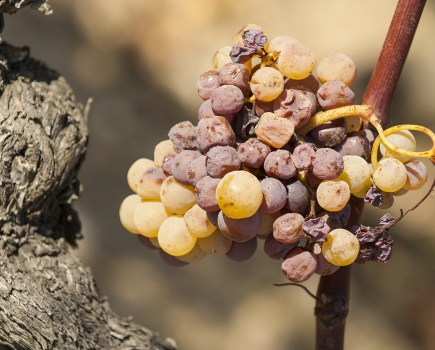Spotted-winged drosophila or SWD for short has been a pest in the UK for several years now, but it was only last year that it reared its head as an issue for grape growers.
Several vineyards, particularly those in Kent, suffered as grapes quickly became affected – leading to the development of botrytis and sour rot in the ripening bunches. These sour rot symptoms can play havoc in the winery. Acetobacter spread by the SWD can cause problems in the early stages of wine production resulting in high volatile acidity in wines. Late harvested and thin-skinned varieties are particularly at risk. However, good practice in the vineyard can minimise the impacts of this pest, both in the field and the winery.
So what should you do in the vineyard?
Monitor
Monitoring for pest presence is important, especially where SWD hasn’t been an issue for you in the past, as being caught out can have a severe impact on production. Best practice for monitoring, as developed by NIAB EMR, is to place traps in particularly susceptible areas; one in the hedge row/field margin, one at the edge of a vineyard and one in the centre of the crop. This approach is intensive and can be streamlined as you begin to understand more about the pest pressure in your vineyard.
Suitable traps should ideally contain lures such as apple cider vinegar or commercial baits such as Dros’attract. The most effective traps are red as this is attractive to the fly.
Leaf-strip
SWD have been found to lay more eggs in humid conditions so leaf stripping both sides of the canopy prior to veraison will enhance air-flow and therefore reduce egg lay and the damage that ensues.
Vineyard hygiene
Harvest and pressing are the busiest times in the vineyard and winery with everyone working flat out, but it is important to maintain vineyard hygiene, such as removing mummified or rotting bunches and keeping any mark out of the vineyard. If there is no other way to dispose of mark, it should be incorporated into the soil ideally to a depth of 15cm.
Chemical controls
Currently chemical controls in the vineyard are limited, and are focussed around the use of Tracer. That said, Wines of Great Britain has submitted an application for an Emergency Approval for the use of Exirel in vines. If this proves successful the product should be available to growers in early August, just in time for use in the run-up to picking early varieties at the start of September.
Other chemicals are currently available including; Hallmark, Pyrethrum 5EC and Spruzit. However, these chemicals lack the systemicity of Exirel and efficacy of Tracer. Exirel would be of particular use given its larvicidal activity. Both these products have been shown to provide effective control for 7 days, ideally growers would rotate between both products, before using Hallmark as a final spray if necessary to extend protection into the final week of ripening. Current work at NIAB EMR is looking at extending the spray intervals.
When do I spray?
Spraying should be started at veraison as the grapes begin to ripen and change colour, as the grapes become softer and riper they become more susceptible. Wayne Wilcox has highlighted that sour rot becomes particularly prevalent when grapes reach above 15° Brix.
Organic and biodynamic vineyards
Where conventional chemical control is not available it is essential to maintain all cultural controls but you could also concentrate more on:
- Exclusion netting – where pressures are high success has been achieved using fine-meshed insect netting to exclude SWD from the vineyard
- Dead-end hosts – some species of plant do offer potential as egg-laying sites which prevent larval development thus slowing the rate of reproduction and lowering population pressure
- Precision monitoring – the use of precision monitoring, placing traps around the perimeter of the crop adjacent to wild areas at a two-metre spacing, will also help to reduce the movement of adult SWD into the crop.
Despite this year’s cold winter and the late frosts reducing the natural populations, SWD is again expected to be a widespread problem, especially with harvest looking like it will be at least as early as last year. As ever with a pest and disease issues it is most important that all the vineyard staff are aware of the symptoms associated with SWD and are able to report any problems as soon as they arise, in order to correctly manage any problems.



